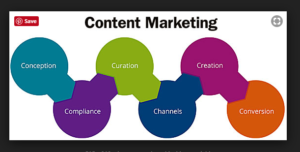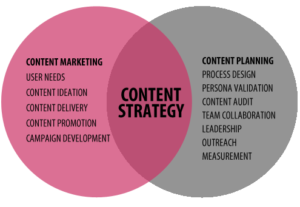If you’re a small business, a content marketing plan should serve as the backbone of your marketing plan. There are a huge plethora of prospective customers ready and waiting to be harnessed via the world of social media. In a recent study carried out by the Marketing Institute, over 80 of B2B marketing strategies follow a robust content marketing plan. In this fast-paced tech-savvy world, a content marketing plan isn’t optional – it’s essential.

What is a content plan?
No matter how small your business is, if you’re a startup or have been trading for years, you’ll always want to improve and refine your plan, so what should the ideal plan constitute? A content marketing plan should reflect your creation and distribution of valuable and relevant content to acquire, attract, and engage new customers from your target audience. The final goal will be to drive your viewers into satisfied customers.
Content strategy plan … laying the foundations
Before you get to work on your plan, you’ll need to don your analytical thinking cap, and put in the necessary groundwork. Failure to lay the foundations for your plan can lead to your its collapse, and failure to get your brand moving to its best potential, wasting your resources and opportunities.
Carry out competitor auditing and analysis. Your competitors have risen for a reason, so take notes of both their brand position and their content marketing. What are they doing well that you should be doing too? Don’t forget that the plan is a learning curve and you need to start learning immediately. Scan over your competitor’s landscape and see what they’re publishing, where and at what time. What channels are the most active on and how are they harnessing each channel effectively? You’ll ultimately want to offer the best content that will knock them off the top spot, but for now, you can start by emulating their success.
Perhaps through your analysis, you’ll spot what your competitors are NOT doing. Is there a gap in the content offered that you can fill? Maybe, you have the best in-house expertise and can offer a key solution. If you don’t find out, you won’t know; and you could be missing out if you’re not sure. Take time to review your company’s strengths and weaknesses when looking at opportunities for you to grow.

Mine data from your competition and your customers to understand how consumers interact with content. If you can work out what your ideal customer needs, you can come up with key questions that your customers will be asking and work to answer them; this can help inspire the content that you will produce.
Content marketing plan … your brand – your style
You may find that you have given your brand a lot of thought by now, but if you’re trying to deliver the best content you can, you’ll need to be aware of your brand’s position and how your content can be tailor-made. Take a moment to review these points:
Who is your target customer?
How can you provide proof of your benefit?
What problem can you solve and how can you get this across?
How can you make an emotional connection?
How can you create a line that sums your brand’s benefits up?
What do you want your brand to mean to people?
It’s important that you write down who your ideal customer is, and how you can tailor content to help them come to you for solutions to their problems. You’ll want to craft your content with the chosen audience in mind, narrowing down to your ideal customer. Think about some of these questions in your plan:
Where do your customers come from?
How old are they?
What are their demographics?
What’s important to your customers?
Where can you source your audience?
You’ll want to note down your brand’s visual identity. It’s important to stay true to this and your brand’s style without deflating or diluting it at any point. An eclectic and disparate look to your brand won’t help cement your identity in the minds of your audience. Refer to your logo and how it should be used, your colors and themes, your context, your written and visual approach. Your style will need to shine through.
What content?

There is a variety of different content for every business to tailor to their needs. Whether you’re looking to publish a blog or a podcast, make sure that it is informative and valuable for your users. You won’t want your content to make a hard sell, but the idea will be to have something that a user can take away so that they look to you in the future for providing more solutions to their problems. Each social media channel works best for different content publishing, so do some research and think about where you can publish for the best results.
Topics
Note down what kind of topics you’ll want to publish. There are a variety of ways to get ideas for topics:
Look at customer interactions online to help inspire new content – customer feedback, social media conversation, customer FAQ’s. If you’re looking to create blogs, you could look into websites such as com to outsource creative work and wiring decisions.
Carry out competitor analysis to see what content competitors are creating.
Carry out keyword analysis to align your content with SEO as best you can.
Format
There are numerous different formats to try out, each specific to certain social media. Make sure you note down which you’re using in your plan. Many options are available, for instance:
Blog posts
Podcasts
Videos
Guest blogs for other online websites
Slideshows
Memes and viral content
Infographics
Pictures
Whitepapers
eBooks
Downloadable templates
Newsletters
Guides
Budgeting
Most social media marketing can be done for free, but sometimes you’ll want to pay for a variety of different extensions for automation and analytics. You may also want to outsource some creative work to others to save you time. Make sure you put a detailed account of how much to spend for what purpose in your plan.
Now that you’ve laid the foundations and done the groundwork, you can get to the practical aspects: looking at goals, tactics, strategy and KPI’s for your content to be marketed. Where are you heading? How will you get there? What will success look like?
Time and Date
Create a content calendar so that you know what to publish and when. Both “what” and “when” are equally important – you’ll want your content to be as engaging as possible. Create a strict schedule for when to publish and adhere to this; to what audience, what tone, what platform and what kind of content?
A schedule of content publishing will help you plan and stay organized, amending your strategy and refining it along the way to keep optimizing. Of course, sometimes you’ll want to make room in your plan for spontaneous content.But with a strict schedule, you can make use of the correct social media management tools to automate sending of your content at appropriate times. This helps you to make the most of your content marketing resources.
Allocate a schedule to allow flexibility for content marketing that you can’t anticipate, e.g., time to respond to customer queries and content questions. You’ll need to think with your business mind and work out a decision that works best for your company. Similarly, work out how much time and resources you’ll be dedicating to ad-hoc content. Along with the deal example above, you’ll want to think about content sharing that you can’t anticipate, such as the following:
Business success stories;
Stories from satisfied customers;
Big news stories in your field;
Content that gets on board with viral trends.
How often should you rely on ad-hoc content and how valuable would it be to your brand? To what extent should it take priority and what can you anticipate? Each decision you plan should be specific to your business alone. Plan and allocate time in your calendar.
An ongoing learning curve
Marketing strategy is all about learning and refining over time. When you’re putting your plan into action, you may find that what you’ve planned doesn’t work, and you may discover different ways of doing things that work better for you. Make sure that with whatever strategy you follow, you keep note of what works best, and analyze results in an organized and detailed manner. You can use a whole variety of great third-party applications to help you do this, and you should, certainly, mention which to use and how to use them in your plan.
The bottom line
Stay patient and refine until you find a successful formula for you to use. It’s all a journey and a process of self-discovery, but whatever you do, make sure you work hard and plan smart.
